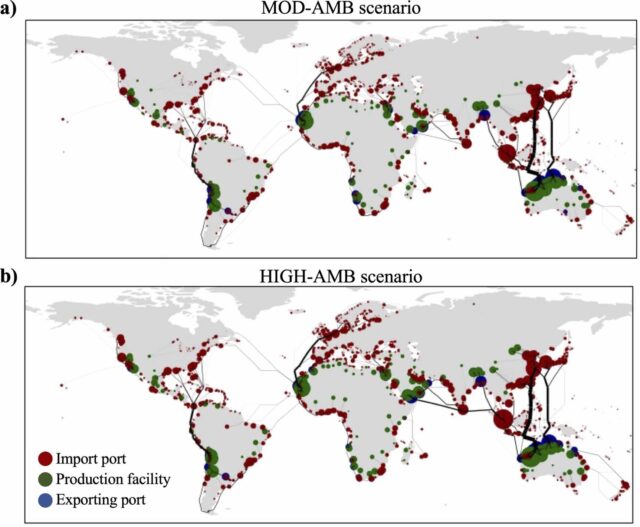Target top regional fuel ports, spend $2 trillion to enable ammonia marine fuel by 2050
By Julian Atchison on March 19, 2024
60% of global demand could be met by 2050
New Oxford research finds that over 60% of global shipping fuel demands could be met by ammonia marine fuel in 2050. This can be achieved by targeting renewable ammonia fuel supplies at the “top 10 regional ports”, or the ten biggest fuel ports in each of ten global shipping regions. $2 trillion will need to be spent to transition to a fuel supply chain, primarily to finance supply infrastructure. About half this investment is needed in low and middle income countries – providing an opportunity for “foreign investments and green jobs.”

Click to enlarge. Optimal spatial fuel supply to meet global port fuel demand in Moderate and High-Ambition scenarios to 2050. Figure 3 from Verschuur et al., “Optimal fuel supply of green ammonia to decarbonise global shipping”, (Environ. Res.: Infrastruct. Sustain., Jan 2024)
…the greatest investment need is in Australia, to supply the Asian markets, with large production clusters also predicted in Chile (to supply South America), California (to supply Western U.S.A.), North-West Africa (to meet European demand), and the southern Arabian Peninsula (to meet local demand and parts of south Asia).
From Green ammonia could decarbonize 60% of global shipping when offered at just 10 regional fuel ports, 9 Jan 2024
On the fuel supply side, the research team predicts a tightly grouped, “regionalisation of supply”:
…entailing a few large supply clusters that will serve regional demand centres, with limited long-distance shipping of green ammonia fuel. In this cost-efficient model, practically all green ammonia production is predicted to lie within 40° latitudes North/South.
Abstract from “Optimal fuel supply of green ammonia to decarbonise global shipping”, (Environ. Res.: Infrastruct. Sustain., Jan 2024)
The implications of this work are striking. Under the proposed model, current dependence upon oil-producing nations would be replaced by a more regionalised industry; green ammonia will be produced near the equator in countries with abundant land and high solar potential then transported to regional centres of shipping fuel demand.
René Bañares-Alcántara, Professor of Chemical Engineering in the Department of Engineering Science at the University of Oxford in his organisation’s official press release, 9 Jan 2024
The researcher team also predicts that global production of renewable ammonia could reach between 602 – 750 million tons per year. This up to four-fold increase on current global production levels will be driven by demand for alternative maritime fuel – a similar forecast to that made by Mission Possible Partnership in their 2022 report Making net-zero ammonia possible.